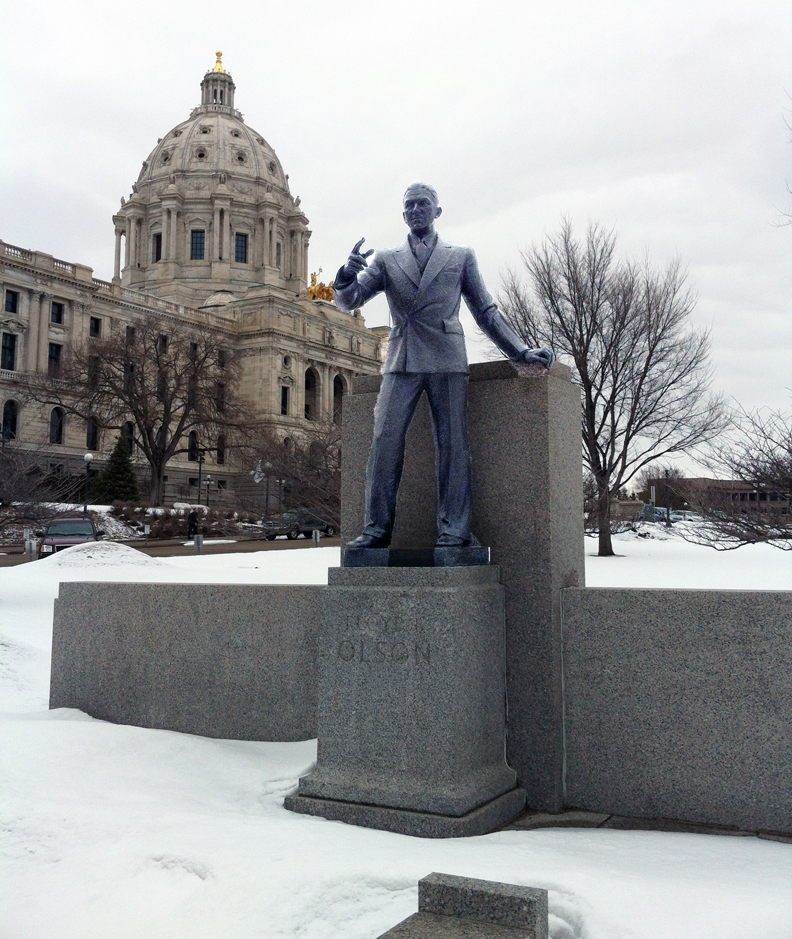In search of Scandinavian Minnesota
In search of Scandinavian Minnesota
-
 Governor Floyd B. Olson, the legendary Depression leader in Minnesota.
Governor Floyd B. Olson, the legendary Depression leader in Minnesota. -
-
I just returned from a week in Minnesota, about which Swedish writer and feminist activist Fredrika Bremer wrote way back in the 1850s, “What a glorious new Scandinavia might not Minnesota become.”
Minnesota did become that new Scandinavia, with hundreds of thousands of Swedish, Norwegian, Danish, Finnish and Icelandic immigrants settling there during many decades up until 1930. Today, 32 percent of Minnesota’s 5.4 million people are of Scandinavian descent, an important part of Minnesota’s legacy and an important part of modern Minnesota.
Winter still covers the ground in the upper Midwest, just south of the Canadian border, with piles of dirty snow along the roads and icy and treacherous sidewalks—just like it used to be in my childhood’s Stockholm. The air is crisp and biting, unlike where I now live, in Washington, D.C. And by this time of the year, everyone longs for spring.
But a quick look at the Twin Cities—Minneapolis and St. Paul—does not otherwise reveal many similarities with Stockholm between Lake Mälaren and the Baltic Sea, although the Mississippi River meanders impressively through the two cities. A sign at the airport says, for some reason, “Sköl,” which, of course, does not exist in Swedish. Famous restaurant Aquavit from New York City opened there a decade or so ago, but had to close a few years later.
A new restaurant, The Bachelor Farmer opened last year. According to the New York Times, it “has given Scandinavian food a much needed adrenaline shot." It’s a modern, friendly place, and very difficult to get a table. It seems that Minnesotans like what they serve—appetizers like “bibb lettuces, aged goat’s milk cheese, cider vinegar, walnuts” or “crispy oyster mushrooms, roasted celery root, crème fraîche, apple, rosemary” and toast with “split pea purée, whipped crème fraîche, pickled golden beets, almonds, buckwheat honey” and entrées like “poached eggs, beluga lentils, roasted butternut squash, leeks, sweet potato” and “stuffed rabbit leg, white bean ragoût, glazed cipollini onions.”
That’s a long way from traditional Scandinavian cuisine, like gravlax, herring, meatballs or Västerbotten cheese. To find that, one has to go to Fika—the modern, new restaurant in the American Swedish Institute’s (ASI) splendid new wing, the Nelson Cultural Center. It opened last year next to the classic mansion that Swedish newspaper publisher Swan Turnblad donated in 1929 to what eventually became the American Swedish Institute.
What a site it all is, dominating Park Avenue in the middle of Minneapolis, to the envy of the Norwegians, who are still discussing, after many years, how they can create something similar … ASI director Bruce Karstadt is rightly proud and excited about his institute’s future.
In the search for Minnesota’s Scandinavian legacy, Scandinavian Studies programs are alive and well at several universities and Swedish language classes in Kjerstin Moody’s classes at Gustavus Adolphus College in St. Peter, about an hour south of the Twin Cities, and in Lena Norrman’s classes at the University of Minnesota in Minneapolis have plenty of students. And their knowledge of Swedish is impressive.
But maybe the most obvious proof of Minnesota’s Scandinavian heritage is found at the gorgeous State Capitol in St. Paul, designed by the prominent architect Cass Gilbert, who also designed the U.S. Supreme Court building in Washington, D.C. The three big statues in front of the Capitol’s entrance are of Governors Knute Nelson, born in Norway, Swedish-American John A. Johnson, and Floyd B. Olson, the legendary Depression leader. And inside, the halls are filled with the portraits of previous governors—John Lind and Adolph O. Eberhart, both born in Sweden, and of a long series of Norwegian-, Swedish-, and Danish-Americans by the name of Anderson, Andersen, Benson, Burnquist, Christianson, Rolvaag, Petersen and Arne Carlson.
After Carlson, Minnesota has been led by Jesse Ventura, Tim Pawlenty, and now Mark Dayton—none of whom have Scandinavian roots. But there is still hope.… -
By Klas Bergman
-
-
